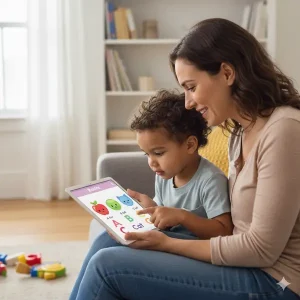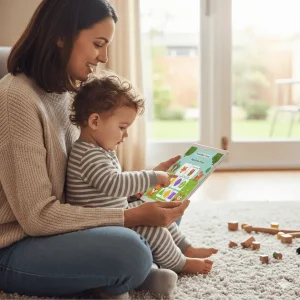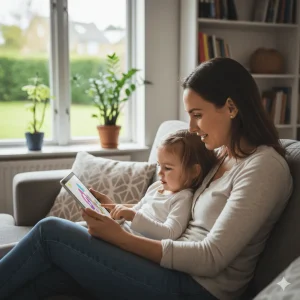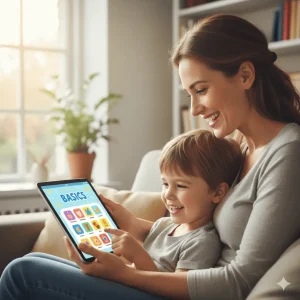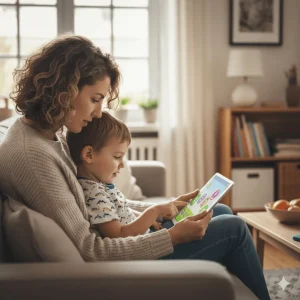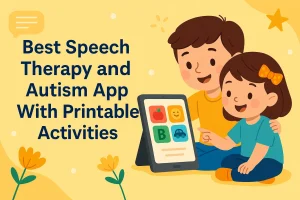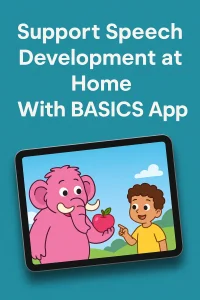How BASICS App Turned Daily Screen Time Into Speech Learning Time
By Wellness Hub
Last Updated: October 22, 2025
In today’s world, screens are everywhere—from morning cartoons to evening routines. For many parents, especially those raising toddlers and preschoolers, managing screen time often feels like a constant battle. You want your child to learn, explore, and have fun, but too much passive screen use can affect speech and attention development.
That’s where the BASICS App brings a refreshing change. Instead of discouraging screen time, BASICS app helps parents turn it into a meaningful learning opportunity. Designed by expert speech therapists, the app transforms everyday digital play into engaging, language-rich experiences that strengthen vocabulary, articulation, and attention.
In this guide, you’ll discover how BASICS app transforms daily screen time into interactive speech learning time—helping your child go from watching to responding, and from tapping to talking. Whether your little one is just beginning to say their first words or practicing sentences, BASICS makes every minute on the screen count.
The Screen Time Dilemma for Parents
Why screen time worries parents of toddlers and preschoolers
For most parents today, managing screen time for toddlers has become one of the biggest challenges in early childhood. Digital devices can easily capture a child’s attention, but not always in healthy ways. Many children spend hours watching cartoons or videos that offer visual stimulation without real interaction, which can affect how they listen, respond, and communicate. When screen time becomes passive, it often replaces the meaningful back-and-forth exchanges that build speech and language.
How passive screen use affects speech development
Speech and language develop through repetition, imitation, and shared communication. However, passive screen exposure—where children only watch but don’t respond—can slow this natural learning process. Studies have shown that excessive, unstructured screen time can lead to speech delay, shorter attention spans, and limited vocabulary growth.
Without opportunities to listen, think, and reply, children may struggle to form connections between words and real-life meanings. This is where parents begin to notice fewer spoken words, less eye contact, and reduced engagement during play.
In contrast, interactive learning experiences—where children tap, listen, and respond—activate both auditory and visual systems, promoting language comprehension and memory. The key isn’t avoiding screens altogether, but making screen time purposeful and guided.
The need for structured, therapist-designed engagement
Instead of banning screens, experts recommend using educational apps that encourage children to think, respond, and communicate. This approach gives screen time a defined role in early learning. Therapist-designed platforms, like the BASICS App, follow a structured learning path where every tap, sound, and activity is crafted to support speech development.
These activities mimic the natural steps of communication—listening, naming, repeating, and responding—making digital play both fun and educational. For children with speech delay or emerging communication, guided app experiences can bridge the gap between home routines and therapy goals.
Bridging the gap between entertainment and education
Not all screen time is created equal. While entertainment-focused apps keep children occupied, educational and interactive learning tools turn the same screen into a space for growth. The BASICS App was designed to meet parents halfway—offering the fun of games while embedding the science of speech therapy into every activity.
It transforms what could be idle viewing into meaningful, skill-building moments. By replacing random scrolling with intentional play, parents can turn everyday screen time into an opportunity to boost attention, vocabulary, and communication skills—all while keeping learning enjoyable and pressure-free.
What Makes BASICS Different From Regular Kids’ Apps
Most kids’ apps are designed for entertainment—colorful videos, quick games, and endless autoplay. While these may hold a child’s attention, they rarely help build real communication. The BASICS App changes that completely. It’s not just another game; it’s a speech therapy app created by professionals who understand how children learn to talk, listen, and think.
Designed by Speech Therapists
Every feature in BASICS is built with a therapeutic purpose. Expert speech therapists have structured each activity to support language milestones—like imitation, attention, articulation, and word recall. This professional foundation ensures that what looks like play is actually a guided path toward stronger communication skills.
Visual-Based, Interactive, and Guided
Unlike typical apps that rely on passive watching, BASICS app encourages active participation. Each task asks the child to listen, tap, identify, or respond—transforming every screen minute into real engagement. The visuals are carefully chosen to match a child’s learning level, while guided voice prompts keep them focused and motivated. It’s an educational game for speech that uses visual and auditory cues to make learning natural and enjoyable.
Real-Life Vocabulary Through Pictures, Sounds, and Actions
BASICS connects digital learning to the child’s real world. Instead of random cartoons, it features real-life images, everyday objects, and meaningful sounds—helping children link words to things they see, hear, and use daily. This approach strengthens both receptive (understanding) and expressive (speaking) language, making it one of the most practical speech therapy apps for home use.
Gradual Progression: From Matching → Words → Sentences
The BASICS App follows a step-by-step structure that mirrors how children naturally acquire language. It begins with simple matching activities that build attention and memory, progresses to word learning through visual modeling, and finally advances to sentence formation and conversation practice. Each level builds on the previous one, ensuring consistent progress without overwhelming the child.
With its therapist-designed structure, real-world visuals, and guided interactivity, BASICS app stands out as a true speech therapy app; transforming everyday screen time into meaningful learning that promotes lasting communication growth.
What Makes BASICS App Different From Regular Speech Therapy Apps
Parents often download multiple speech therapy apps hoping to find one that truly keeps their child engaged while improving communication. But many apps rely on autoplay videos or repetitive flashcards that don’t actively teach children to listen, think, and respond. The BASICS App stands apart by turning every interaction into a guided learning experience that mirrors how real communication develops.
Designed by Speech Therapists
Unlike most educational apps, BASICS app is created by a team of certified speech therapists who understand how children learn to communicate. Every activity—from matching pictures to answering WH questions—is structured with a therapeutic purpose. The app focuses on natural language progression: helping children listen, imitate, and speak through guided play rather than memorization. This therapist-driven design ensures that BASICS App doesn’t just entertain—it builds real speech and language foundations.
Visual-Based, Interactive, and Guided — Not Autoplay or Passive Viewing
Many apps keep children occupied but not engaged. BASICS App changes that by replacing passive screen time with interactive speech therapy games. Each activity encourages your child to look, tap, and respond—building attention, focus, and turn-taking skills. Instead of simply watching animations, children learn to connect what they see with what they hear, a critical step for speech and comprehension growth. This visual and auditory feedback loop keeps learning fun while improving listening and pronunciation.
Real-Life Vocabulary Through Pictures, Sounds, and Actions
BASICS App introduces children to functional, real-world vocabulary—from fruits and animals to emotions, toys, and everyday actions. Every image, sound, and animation is carefully chosen to reflect what children experience in daily life, helping them make natural connections between objects and words. These educational games for speech help kids label, describe, and use new words in meaningful ways, making it easier to apply what they learn beyond the app.
Gradual Progression: From Matching → Words → Sentences
The BASICS App is built around a step-by-step speech development framework. Children start with simple matching games that build attention and recognition, move to naming and vocabulary exercises, and gradually advance to sentence-building activities. This structured flow mimics real speech milestones—starting from imitation and single-word use to longer, more confident sentences. It’s a complete learning pathway that makes BASICS App more than a typical speech therapy app—it’s a guided journey from sounds to full communication.
Turning Screen Time Into Learning Moments
For most families, screen time has become a part of daily life—but what if every minute your child spends on a device could actually build communication skills? That’s exactly what the BASICS App achieves. Instead of passive watching, it transforms screen time into a series of speech learning games that promote attention, imitation, and meaningful language use.
Unlike traditional videos that your child simply watches, BASICS App invites active participation. Each activity is designed to mimic real-life interactions—the kind that spark speech and understanding. When your child taps a picture after hearing a word, they’re not just playing; they’re practicing receptive and expressive language in a fun, interactive way.
For example, when the app says “Tap the apple,” and your child correctly selects it, that simple action reinforces listening, comprehension, and articulation. Over time, these small moments lead to big changes in how children recognize sounds, name objects, and use words confidently.
Repetition and positive feedback are core to the BASICS App learning approach. Each correct response triggers encouraging sounds and animations, motivating children to keep trying. This kind of interactive speech therapy app design keeps the experience joyful and rewarding while strengthening neural connections related to language and memory.
The activities also focus on everyday categories that children easily relate to—animals, foods, toys, body parts, and colors—making each interaction meaningful and practical. Whether it’s matching a cat, naming a banana, or identifying a red ball, every task builds early comprehension and helps connect visual images with spoken words.
Through these playful, structured interactions, BASICS App turns routine screen time into early language learning moments that truly matter—helping children engage, respond, and express themselves with growing confidence.
The Science Behind BASICS App Learning Approach
The BASICS App is built on one powerful idea — that children learn best through play. Every tap, sound, and visual cue in the app is rooted in developmental research that supports how young minds absorb, retain, and apply language. Instead of relying on rote memorization or flash drills, BASICS uses play-based learning to naturally stimulate speech and cognitive growth. This makes it an ideal speech therapy app for parents who want to support communication at home in a relaxed, fun way.
Play-Based Speech Learning Backed by Developmental Research
Research in early childhood development shows that play is not just entertainment — it’s how children build language, reasoning, and emotional understanding. Play gives meaning to new words and allows repetition without pressure.
The BASICS App transforms these principles into interactive experiences where children match, tap, and listen to build associations. Each activity is structured to provide language stimulation — a balance of seeing, hearing, and doing that strengthens both receptive (understanding) and expressive (speaking) language skills.
Therapists often use play to promote speech because it keeps children motivated and engaged. BASICS app recreates that same environment digitally, turning screen time into purposeful learning. It’s not just another app — it’s speech delay therapy at home, designed to follow how kids naturally learn and communicate.
How Visual and Auditory Pairing Helps Children With Speech Delay
Children with speech delays often benefit from multisensory teaching — when they can see, hear, and interact with a concept at the same time. BASICS app uses visual and auditory pairing in every activity: a child hears “apple,” sees the image, and taps the correct picture. This strengthens word-object connections and supports the brain’s language mapping process.
The app also encourages imitation through videos and guided prompts, helping children model correct pronunciation and sentence use. This is a cornerstone of speech therapy at home — giving kids repeated exposure in a fun, low-pressure environment. For children with autism or developmental delays, this multisensory pairing makes communication more accessible and meaningful.
Reinforcing Attention, Imitation, and Memory During Play
For speech learning to stick, children need to focus, imitate, and recall information — all skills that BASICS app develops gradually.
Each game challenges children to listen closely, observe visual cues, and respond by matching or naming. Over time, this strengthens attention span, working memory, and imitation, which are essential for both speech and overall learning.
BASICS app structure follows a developmental sequence: starting with simple matching, then moving to naming, sentence formation, and comprehension. This gradual progression keeps children in their comfort zone while gently increasing cognitive demand — exactly how therapists design sessions in speech delay therapy at home programs.
How BASICS App Aligns With Early Intervention Goals
Early intervention focuses on building communication, attention, and social engagement through consistent practice. The BASICS App mirrors this approach with therapist-designed goals that can be used daily, even outside therapy sessions.
Each goal targets a specific developmental milestone — from identifying sounds and objects to answering WH questions and forming full sentences. Parents can track progress, reinforce therapy sessions, and create a consistent communication routine without needing specialized equipment.
By combining evidence-based learning with real-world usability, BASICS app serves as a complete language stimulation app — bridging the gap between therapy centers and home environments. It helps children not only learn to speak but also connect, respond, and express themselves confidently.
Real-Life Scenarios: When Screen Time Becomes Speech Time
Parents often wonder how to turn everyday moments into learning opportunities—and that’s exactly where the BASICS App fits in. With a few minutes each day, you can transform ordinary screen time into meaningful speech activities for toddlers that build communication, focus, and interaction naturally.
Snack Time Becomes a Speech Practice Moment
Imagine your child enjoying snack time while naming what they see on the screen—“apple,” “banana,” or “cookie.” Using the speech therapy app for kids, parents can encourage their child to repeat words, identify food items, or answer simple yes/no questions. This playful repetition helps children strengthen articulation, improve word recall, and learn to communicate about things they encounter every day.
Waiting Time Turns Into Language Learning
Whether it’s at the doctor’s office or during a car ride, waiting moments can easily become speech therapy at home sessions. Parents open the BASICS App for a quick matching or naming game. These short bursts of interactive play help toddlers stay engaged while practicing essential speech and language skills. In just 5–10 minutes, children learn to listen, point, and speak—transforming downtime into productive communication time.
Bedtime: Ending the Day With Connection and Conversation
Before bed, families use the app’s calming visual stories or simple speech app games that involve naming emotions or describing pictures. This quiet, guided playtime encourages children to express what they feel and builds emotional vocabulary. Parents love how these activities not only promote language development but also strengthen bonding through shared learning experiences.
Tracking Progress That Parents Can See
Every small interaction inside the parent-child learning app is recorded in the progress tracker, allowing families to visualize improvements over time. Parents notice gradual gains—more consistent word use, longer attention spans, and clearer pronunciation. The progress tracking feature reinforces confidence, showing that even a few minutes a day of guided screen time can lead to visible communication growth.
Making Screen Time a Family Activity
Unlike traditional videos or cartoons, the speech therapy app invites parents to participate. Many families sit together, take turns answering questions, or act out actions shown in the app. This shared interaction turns learning into a family game—encouraging laughter, bonding, and connection while supporting speech development goals.
With BASICS App, screen time isn’t wasted—it’s transformed into a daily opportunity for communication, creativity, and connection. Every tap, word, and smile brings your child closer to confident speech—proving that learning can happen anywhere, even on a screen.
How BASICS App Encourages Meaningful Parent Involvement
Parental involvement plays a crucial role in a child’s speech and language development. The BASICS App is designed to make parents an active part of the learning process—not just observers. Instead of letting screen time become passive entertainment, BASICS transforms it into guided speech learning, where parents help children connect digital practice with real-world communication. Through features like Goal Mode, Library Mode, and built-in progress tracking, parents can personalize activities, monitor milestones, and reinforce language skills beyond the screen.
Goal Mode and Library Mode for Customized Practice
The BASICS Goal Mode allows parents to select learning targets such as matching, vocabulary, WH questions, or sentence building, based on their child’s current needs. Each goal aligns with therapist-designed learning paths, making the app suitable for children with speech delay, autism, or general language development needs.
In contrast, the Library Mode gives families freedom to explore. Parents can pick topics their child enjoys—like animals, toys, or colors—and revisit them for extra practice. This balance of structured and open-ended options helps maintain engagement while supporting individualized speech learning at home. Parents can track progress after every set, celebrating achievements and adjusting focus areas as needed.
Encouraging Conversation and Repetition Outside the App
The true strength of the BASICS App lies in how easily parents can carry learning into daily life. After each activity, the app naturally inspires conversation—asking your child to name, describe, or act out what they learned. Parents can use these moments to encourage repetition and imitation, which are vital for speech clarity and memory.
For instance, after completing a color or food game in BASICS, you can reinforce the same words during mealtime (“Let’s eat the red apple”) or playtime (“Find the blue car”). This bridges in-app learning with real experiences, turning every interaction into a language development activity.
Creating a Consistent Speech Learning Routine from BASICS App
Children thrive with consistency—and the BASICS App makes it easy for parents to set up a daily or weekly routine. Just 10–15 minutes of guided play can make a measurable difference in attention, vocabulary, and articulation.
Parents can start with one goal per day, track progress through the built-in reports, and gradually increase difficulty as their child advances. Consistency builds familiarity, and familiarity builds confidence—helping children use words more naturally across settings.
Using BASICS as part of your family’s routine also encourages mindful screen habits. Rather than leaving children to navigate random videos or ads, every tap in BASICS contributes to focused speech learning supported by parent interaction.
Balancing Screen Time with Real-World Application
The BASICS App isn’t meant to replace human connection—it’s meant to enhance it. By combining short digital sessions with real-world play and talk, parents help children generalize new words and phrases naturally.
For example, if your child learns “brush teeth” in the app, reinforce it during their bedtime routine. If they name fruits on screen, ask them to find those fruits in the kitchen. This integration turns passive screen exposure into purposeful learning and communication.
The result? A healthy balance where children see screens as a tool for learning, not distraction. Parents stay involved, children stay motivated, and every moment spent using the speech therapy app contributes to lasting progress.
From Passive Watching to Active Talking — The Measurable Impact
One of the most rewarding parts of using the BASICS speech therapy app for kids is seeing how quickly screen time transforms from silent scrolling to active talking. What was once a passive activity—just watching videos or tapping colors—now becomes a purposeful learning experience that builds communication, attention, and confidence.
Observable Improvements in Attention and Response
Parents often notice the first changes in their child’s attention span. Activities within the BASICS app are short, interactive, and visually structured to keep toddlers engaged without overstimulation. As children listen, tap, and respond to prompts, they gradually learn to focus on the task at hand. This repeated attention training improves their ability to follow instructions, make choices, and respond more promptly—essential milestones in early communication development.
By pairing visuals with clear sounds, BASICS helps children connect meaning with actions, reinforcing both comprehension and memory. Over time, children begin to anticipate the next prompt, stay focused longer, and actively participate instead of simply watching.
Increase in Expressive Vocabulary and Sentence Length
BASICS is built to nurture language milestones through a carefully layered approach—from naming single objects to forming complete sentences. Every category—animals, foods, toys, emotions, and actions—offers opportunities for children to say new words, describe what they see, and expand their vocabulary naturally.
As children progress, the app introduces phrases and short sentences, helping them combine words meaningfully. Many parents report that their children start to speak in longer, clearer sentences and use the same words during daily routines, showing real-world language transfer. This bridges the gap between speech practice and everyday conversation—one of the hardest yet most crucial steps in language learning.
How the BASICS App Motivates Without Pressure or Overstimulation
Unlike traditional drills or repetitive speech worksheets, BASICS App uses gamified speech learning to keep children motivated. Each task feels like play, with clear visuals, gentle voice prompts, and instant feedback. The app rewards small wins—tapping the right object, naming an item correctly, or finishing a level—building a sense of achievement without external pressure.
This design encourages self-paced learning and prevents frustration, making the process enjoyable for both parents and children. It’s not about competition—it’s about steady speech improvement through consistent, mindful practice. The calm pace and therapist-approved visuals ensure that learning remains stimulating but never overwhelming.
Why Parents Report More Meaningful Screen Use and Family Bonding
Perhaps the most powerful outcome of BASICS is how it transforms family interaction. Parents aren’t just monitoring screen time anymore—they’re sharing it. Co-playing with children encourages natural conversation, joint attention, and laughter. When a child points, names, or answers correctly, parents get to celebrate those small victories together.
This shared engagement strengthens parent-child communication, deepens emotional connection, and makes learning feel less like therapy and more like play. Families report that screen time no longer feels wasted—it becomes a daily ritual that combines fun, focus, and language growth.
Through structured activities and therapist-designed progression, the BASICS app helps toddlers and preschoolers move from passive watching to active communication—building vocabulary, attention, and social connection that last far beyond the screen.
Integrating BASICS App With Speech Therapy and Daily Routines
Parents often wonder how to keep their child’s progress steady between therapy sessions. That’s where the BASICS App bridges the gap between structured speech therapy and everyday learning. By turning short moments—like snack breaks or evening screen time—into guided speech practice, BASICS keeps your child’s progress consistent even outside the therapy room.
This therapist-designed speech therapy app for kids aligns with real developmental goals such as articulation, vocabulary, and comprehension. It’s built to complement professional guidance, ensuring that what your child learns during online speech therapy sessions continues to strengthen through play at home.
How Therapists Use BASICS App Alongside Online Sessions
Therapists use the BASICS App as an extension of their online or in-person sessions. During virtual therapy, professionals can assign specific activities within the app—like sound-matching games, word identification, or sentence formation tasks—to reinforce what’s practiced in therapy.
Since BASICS app is built around speech and language milestones, it provides structured follow-up exercises that encourage children to listen, respond, and imitate correctly. For children with autism or speech delay, this integration helps improve focus, imitation, and consistency.
Reinforcing Articulation, Vocabulary, and WH Questions
The BASICS App provides hundreds of interactive activities designed to reinforce articulation goals, word learning, and question-answering skills. Children can practice speech sounds (/R/, /S/, /L/) in the Articulation Adventures section, build vocabulary in Word Wonders and Vocabulary Valley, and improve comprehension with Inquiry Island through WH questions like What, Where, and Who.
Therapists often pair these in-app activities with verbal modeling and repetition exercises during therapy. This repetition helps children improve clarity, expand word usage, and strengthen sentence formation. Parents can later continue these same exercises at home through the app, ensuring consistent reinforcement between sessions.
How BASICS App Complements Traditional Therapy Homework
Unlike paper-based worksheets, BASICS app keeps children motivated through visual and interactive learning. Activities such as matching words with pictures, tapping the right action, or completing listening tasks engage multiple senses at once—making learning fun and effective.
Therapists can assign BASICS app activities as home speech practice, giving families an easy, screen-based alternative to printed homework. Parents can monitor completion and revisit specific activities anytime, allowing practice without the need for constant therapist supervision.
This hands-on approach helps children generalize what they’ve learned, turning traditional homework into practical, skill-based repetition that feels like play rather than work.
Making Progress Visible Through App-Based Feedback
One of the strongest advantages of the BASICS App is its built-in progress tracking. Every tap, response, and correct answer is recorded, allowing parents and therapists to see measurable growth over time. This real-time data makes it easy to identify strengths, track emerging skills, and adjust learning goals as needed.
Therapists use this feedback to personalize future sessions, focusing more on areas like articulation, comprehension, or vocabulary expansion. For parents, the progress dashboard offers motivation—it turns effort into visible results, helping them understand how daily engagement leads to long-term speech improvement.
By combining BASICS app with ongoing speech therapy, families create a consistent and structured learning loop. It keeps children engaged, supports therapist-led goals, and ensures every minute of screen time works toward better communication.
Tips for Parents to Make Screen Time Count
Screen time doesn’t have to mean passive watching—it can become a powerful tool for speech and language development when used intentionally. The BASICS App helps you make every minute of screen time count by turning digital play into structured, interactive learning experiences. Here are a few therapist-approved tips to help parents guide meaningful screen use at home.
Set Fixed “Learning Play” Times with the BASICS App
Establishing a consistent routine helps children know when screen time is for learning and when it’s for relaxation. Try scheduling 10–15 minutes of BASICS learning play once or twice a day—ideally when your child is alert and engaged.
These short, focused sessions make speech learning enjoyable rather than overwhelming. Regular practice also helps children build attention span, vocabulary, and communication habits over time.
By integrating the BASICS speech therapy app for kids into your daily routine, you create predictability and structure—two key elements that support both learning and behavior regulation.
Co-Play: Join Your Child During Activities for Better Engagement
Children learn best when parents participate. Sitting beside your child while they play on the BASICS app encourages imitation, shared attention, and turn-taking—all vital speech development skills.
Model the words or actions your child is learning. For example, if the app shows a picture of an apple, say, “Apple! I see a red apple,” and let your child repeat it. This co-play strategy transforms app time into an interactive conversation, improving both receptive and expressive language skills.
Research shows that parent involvement in speech therapy—even through digital tools—enhances learning outcomes and helps children connect language to real-world experiences.
Balance On-Screen and Off-Screen Communication Games
While BASICS app offers powerful speech practice, pairing it with off-screen language activities helps reinforce what your child learns. After a BASICS session, encourage your child to point, name, or describe similar objects in real life.
For example, if your child learned about fruits in the app, ask them to identify fruits in the kitchen or at the grocery store. This bridges digital learning with real-world speech opportunities, helping children use words spontaneously outside the app.
Creating a balance between screen-based learning and real-world interaction ensures speech growth is functional, natural, and long-lasting.
Celebrate Progress with In-App Achievements
Children are motivated by progress they can see. The BASICS App rewards every completed activity with stars, badges, or visual cues—helping kids feel proud of their efforts. Parents can view these in-app achievements to track improvements in attention, vocabulary, and pronunciation.
Celebrate these small wins at home. Praise your child for completing a level or mastering a new word—it builds confidence and encourages consistency.
When children feel successful, they’re more likely to look forward to their daily speech learning sessions, turning screen time into a positive, progress-driven experience.
Conclusion
When guided with intention, screen time becomes speech time. By setting routines, engaging alongside your child, balancing real-world practice, and celebrating progress, you can turn digital play into meaningful learning. With the BASICS speech therapy app, every tap, swipe, and smile contributes to your child’s growing communication skills—making technology a partner in their language journey, not a distraction.
Frequently Asked Question
1. Can screen time actually improve speech in toddlers?
Yes—when it’s interactive and guided. Unlike passive videos, the BASICS App uses therapist-designed activities that prompt children to tap, listen, and respond. This turns screen time into active communication practice, which supports speech development.
2. How is BASICS different from other learning apps like Khan Kids or Speech Blubs?
BASICS focuses specifically on speech, language, and communication, not general academics. It’s built by therapists to help children develop real-life skills—like naming objects, answering WH questions, and forming sentences—through structured, play-based interaction.
3. How much daily screen time is ideal for learning?
Experts recommend no more than 1 hour per day for preschoolers, ideally broken into shorter, guided sessions. BASICS fits perfectly into that window, offering 10–15 minute routines that promote language learning without overstimulation.
4. Is BASICS suitable for nonverbal or late-talking children?
Absolutely. BASICS starts with matching, sounds, and imitation-based games, which are ideal for early communication and children who are not yet speaking. It gradually progresses toward words, phrases, and simple sentences at your child’s pace.
5. Can therapists integrate BASICS into online or in-clinic sessions?
Yes. Many speech and occupational therapists use BASICS to reinforce therapy goals between sessions. The app’s structured “Goal Mode” aligns with professional therapy targets, helping track and generalize skills practiced in real life.
6. How does BASICS make screen time interactive instead of passive?
Every BASICS activity requires action—tapping, identifying, listening, or repeating. There’s no autoplay or endless scrolling. Children engage with tasks that build attention, vocabulary, and comprehension, turning screen time into active learning.
7. Can BASICS be used offline or in low-internet areas?
Yes, most BASICS activities can be accessed offline after initial download, making it ideal for families with limited internet access or those traveling. This ensures consistent learning anytime, anywhere.
8. What age group is BASICS designed for?
BASICS is ideal for children aged 2 to 8 years, especially during early speech and language development stages. It’s beneficial for toddlers learning first words, preschoolers forming sentences, and early school-age children improving comprehension.
9. Does BASICS help reduce screen dependency or tantrums?
Yes. Because BASICS offers structured, goal-based activities, children stay focused on learning tasks rather than endless entertainment. Parents often notice calmer, more purposeful screen habits and better self-regulation.
10. Can parents track their child’s speech progress in BASICS?
Definitely. The Progress Tracker in BASICS helps parents monitor completed goals, categories learned, and improvement in response time or vocabulary use—making speech learning transparent and motivating for both parent and child.
Book your Free Consultation Today
Parent/Caregiver Info:
Client’s Details:
* Error Message
